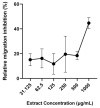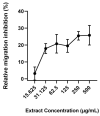Development of In Vitro Assays with the Canine Hookworm Uncinaria stenocephala and Assessment of Natural Plant Products for Anti-Parasitic Activity
- PMID: 37111422
- PMCID: PMC10144190
- DOI: 10.3390/pathogens12040536
Development of In Vitro Assays with the Canine Hookworm Uncinaria stenocephala and Assessment of Natural Plant Products for Anti-Parasitic Activity
Abstract
Enteric helminth infection is an increasing concern in companion animals due to reports of resistance to commonly used anthelmintic drugs. Thus, the assessment of new therapeutic options such as bioactive dietary additives is of high importance. Here, we adapted egg hatch, larval migration, and larval motility assays to screen extracts of several natural ingredients against the canine hookworm Uncinaria stenocephala, a prevalent parasite of dogs in northern Europe. Egg hatch and larval migration assays were established showing that the anthelmintic drugs levamisole and albendazole had strong anti-parasitic activity against U. stenocephala, validating the use of these assays for the assessment of novel anti-parasitic substances. Subsequently, we identified that extracts from the seaweed Saccharina latissima, but not extracts from grape seed or chicory, significantly inhibited both hatching and larval migration. Finally, we showed that α-linolenic acid, a putative anti-parasitic compound from S. latissima, also exhibited anti-parasitic activity. Collectively, our results established a platform for the screening for anthelmintic resistance or novel drug candidates against U. stenocephala and highlighted the potential use of seaweed extracts as a functional food component to help control hookworm infection in dogs.
Keywords: Uncinaria stenocephala; anthelmintic; hookworms; in vitro; seaweed.
Conflict of interest statement
The authors declare no conflict of interest. The funders had no role in the design of the study; in the collection, analyses, or interpretation of data; in the writing of the manuscript; or in the decision to publish the results.
Figures




References
Grants and funding
LinkOut - more resources
Full Text Sources

